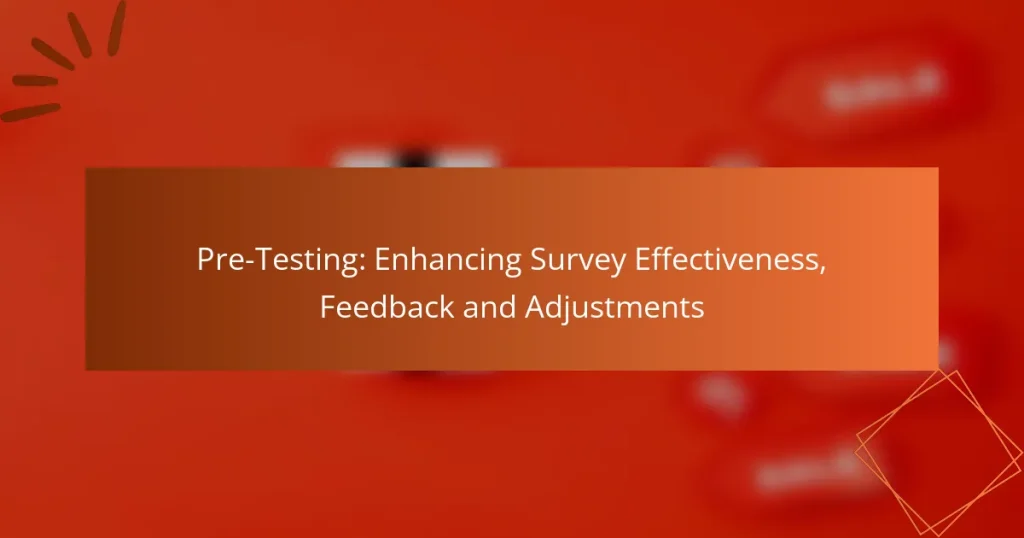Pre-testing is a crucial step in enhancing survey effectiveness by identifying potential issues before the survey is fully deployed. By ensuring that questions are clear and easily understood, this process leads to higher quality data and more reliable insights. Implementing best practices, such as using diverse sample groups and analyzing feedback, further refines survey instruments for optimal results.
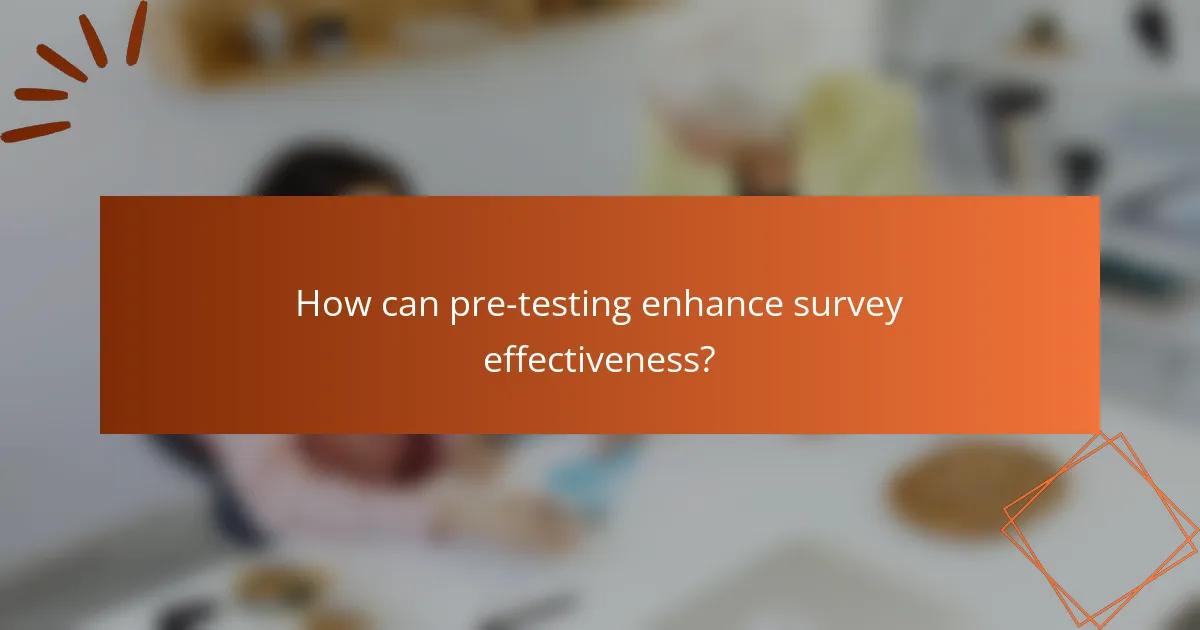
How can pre-testing enhance survey effectiveness?
Pre-testing enhances survey effectiveness by identifying potential problems before full deployment, ensuring that questions are clear and easily understood. This process ultimately leads to higher quality data and more reliable insights.
Identifies potential issues
Pre-testing can reveal various issues such as ambiguous questions, technical glitches, or unexpected biases. By testing the survey with a small group, researchers can pinpoint these problems early, allowing for necessary adjustments.
Common issues identified during pre-testing include confusing wording or answer options that do not cover all possible responses. Addressing these concerns can significantly improve the overall quality of the survey results.
Improves question clarity
Clear questions are essential for gathering accurate data. Pre-testing helps refine questions by ensuring they are straightforward and unambiguous, which reduces the likelihood of misinterpretation by respondents.
For example, if a question is too complex or uses jargon, pre-testing can highlight the need for simplification. This clarity helps respondents understand what is being asked, leading to more precise answers.
Increases response rates
Surveys that are pre-tested often see higher response rates because they are more user-friendly. When questions are clear and relevant, respondents are more likely to complete the survey without frustration.
Additionally, pre-testing can help identify the optimal length and format of the survey, which can further enhance engagement. Shorter, well-structured surveys tend to yield better participation rates, making pre-testing a valuable step in the survey design process.
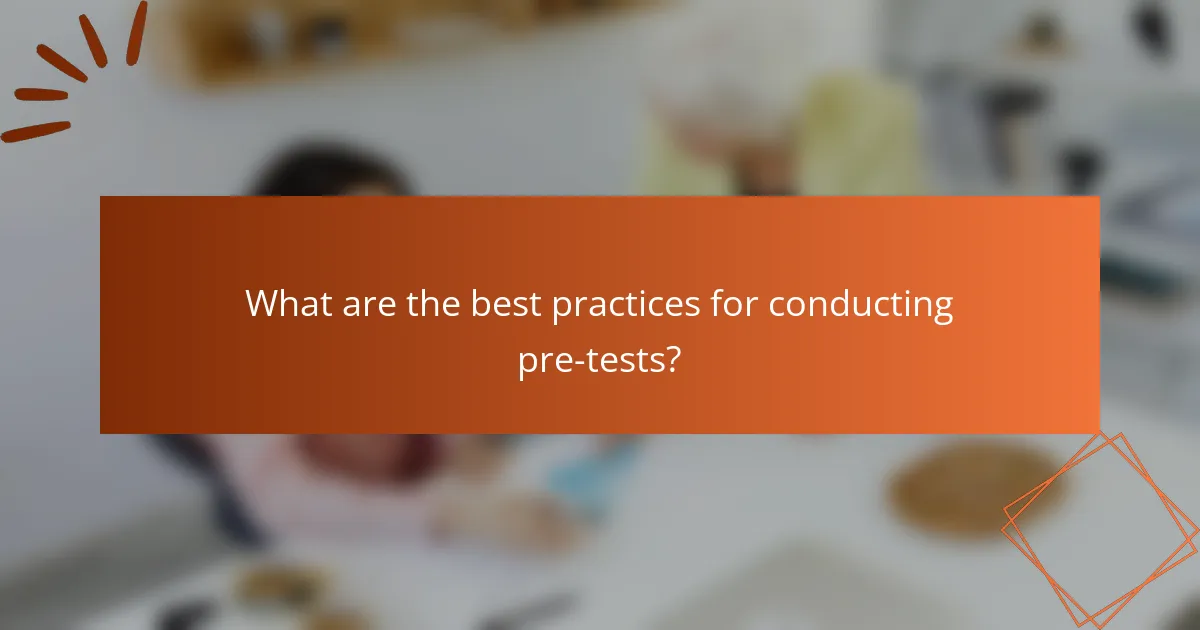
What are the best practices for conducting pre-tests?
Effective pre-testing involves several best practices that enhance survey quality and reliability. Key practices include using a diverse sample group, incorporating mixed methods, and thoroughly analyzing feedback to refine survey instruments.
Use a diverse sample group
Utilizing a diverse sample group ensures that the survey captures a wide range of perspectives and experiences. This diversity can include variations in age, gender, ethnicity, socioeconomic status, and geographic location, which can significantly influence responses.
To achieve this, consider recruiting participants from different demographic backgrounds. For instance, if surveying a product’s usability, include users from various age groups and tech-savviness levels to identify potential issues that may not be apparent in a homogenous group.
Incorporate mixed methods
Incorporating mixed methods in pre-testing combines qualitative and quantitative approaches, providing a richer understanding of participant feedback. This can involve using both structured surveys and open-ended interviews to gather comprehensive insights.
For example, a quantitative survey might measure satisfaction on a scale, while follow-up qualitative interviews can explore the reasons behind those ratings. This dual approach helps identify not just what participants think, but why they feel that way, leading to more informed adjustments.
Analyze feedback thoroughly
Thorough analysis of feedback is crucial for making effective adjustments to the survey. This involves not only reviewing numerical data but also examining open-ended responses for recurring themes and insights.
Consider using software tools that can help categorize and quantify qualitative feedback. Look for patterns in responses that indicate confusion or misinterpretation of questions, which can guide necessary revisions. Regularly revisiting and refining your analysis process can enhance the overall effectiveness of future surveys.
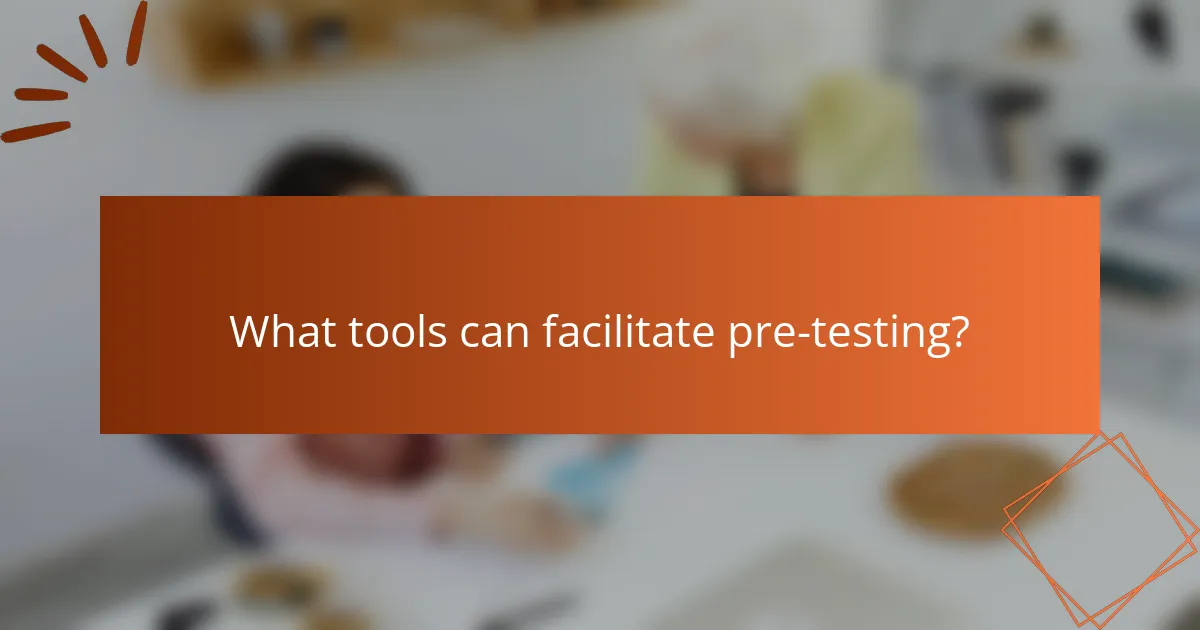
What tools can facilitate pre-testing?
Several tools can enhance the pre-testing of surveys, allowing for effective feedback and adjustments before full deployment. These platforms offer various features to streamline the process, ensuring that surveys are clear, concise, and effective in gathering the intended data.
SurveyMonkey
SurveyMonkey is a widely used tool that provides robust pre-testing features, including customizable templates and real-time feedback options. Users can create surveys and distribute them to a small audience to gather insights on question clarity and overall flow.
One key advantage of SurveyMonkey is its analytics capabilities, which allow users to analyze responses quickly. This helps identify any confusing questions or areas that may require adjustment before launching the survey to a larger group.
Qualtrics
Qualtrics offers a comprehensive suite for pre-testing surveys, focusing on advanced analytics and user experience. It enables researchers to conduct A/B testing on different survey versions to determine which format yields better responses.
With Qualtrics, users can leverage features like embedded logic and branching to refine questions based on initial feedback. This tool is particularly beneficial for organizations that require in-depth analysis and detailed reporting on survey effectiveness.
Google Forms
Google Forms is a free and user-friendly option for pre-testing surveys, ideal for quick feedback collection. Users can easily create surveys and share them via email or social media, making it accessible for diverse audiences.
While Google Forms lacks some advanced analytics features, it allows for straightforward data collection and basic response analysis. This simplicity makes it a great choice for small-scale projects or informal surveys where rapid feedback is needed.
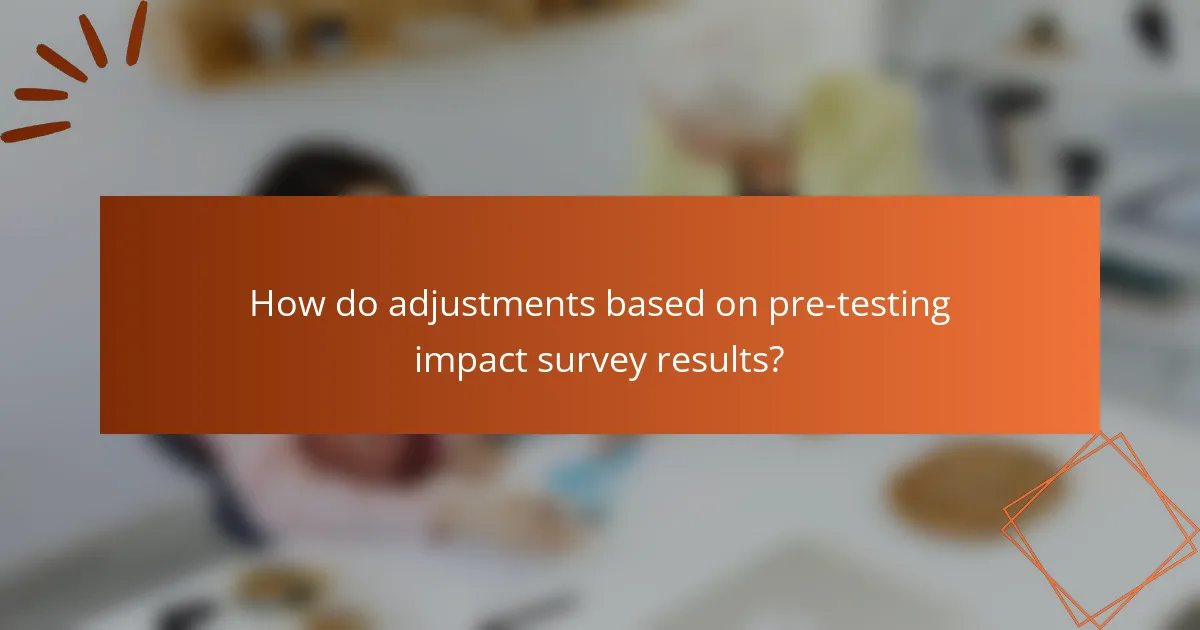
How do adjustments based on pre-testing impact survey results?
Adjustments made from pre-testing significantly enhance survey results by identifying potential issues before the survey is launched. This proactive approach ensures that questions are clear, relevant, and engaging, leading to more accurate and reliable data collection.
Enhances data reliability
Pre-testing helps to identify ambiguous or misleading questions that could skew results. By refining these questions based on feedback, researchers can improve the clarity and precision of the data collected, leading to findings that more accurately reflect participants’ true opinions.
For instance, if a question is interpreted differently by respondents, pre-testing can reveal this discrepancy. Adjusting the wording or format can enhance the reliability of the responses, ensuring that the data collected is consistent and trustworthy.
Reduces bias
Adjustments based on pre-testing can minimize various biases that may affect survey outcomes. By identifying and addressing leading questions or cultural insensitivities, researchers can create a more neutral survey environment.
For example, if a question inadvertently suggests a preferred answer, pre-testing can help rephrase it to avoid influencing respondents. This leads to more balanced responses and a clearer understanding of the target population’s views.
Increases participant engagement
Surveys that have undergone pre-testing are often more engaging for participants. By ensuring questions are relevant and easy to understand, respondents are more likely to complete the survey thoughtfully and thoroughly.
Additionally, pre-testing allows for the incorporation of interactive elements or varied question formats, which can further enhance engagement. For instance, using visual aids or multiple-choice questions can make the survey experience more enjoyable and less tedious for participants.
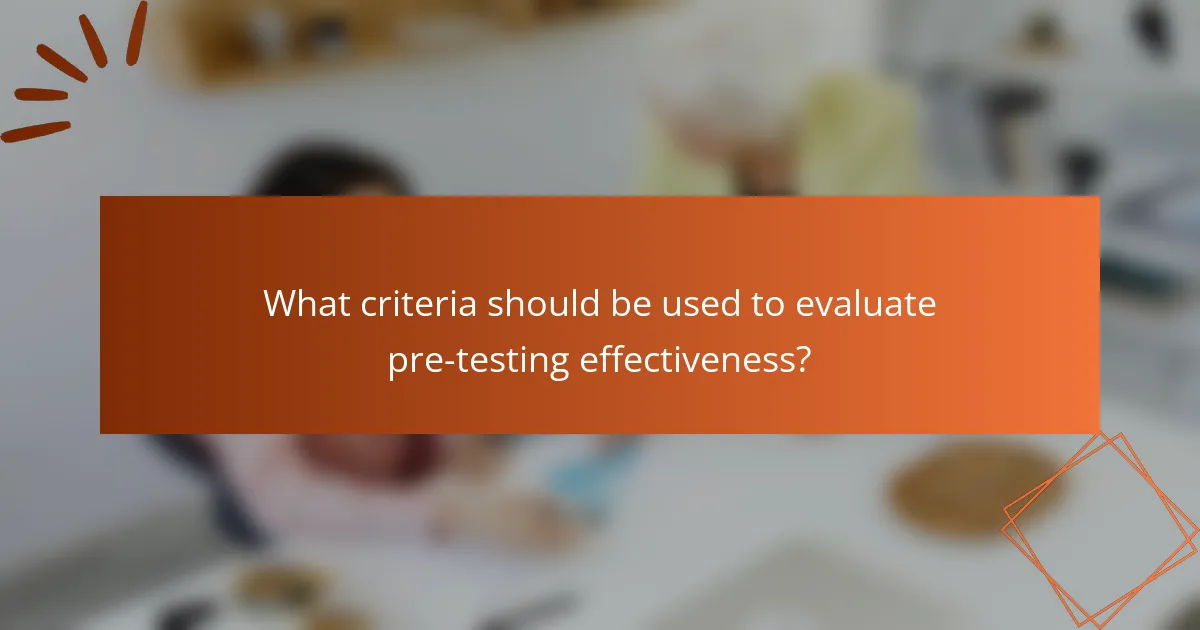
What criteria should be used to evaluate pre-testing effectiveness?
To evaluate pre-testing effectiveness, focus on criteria such as response quality, time efficiency, and participant feedback. These elements help ensure that surveys yield reliable data and are user-friendly, ultimately enhancing the overall quality of the research.
Response quality
Response quality refers to the accuracy and relevance of the data collected during pre-testing. High-quality responses should reflect the participants’ true opinions and experiences, minimizing biases and misunderstandings. To assess this, consider conducting a qualitative review of open-ended responses alongside quantitative metrics.
Look for patterns in the data that indicate clarity and comprehension. For instance, if a significant number of participants misinterpret a question, it may require rephrasing or additional context. Aim for a response rate of at least 70% to ensure sufficient data for analysis.
Time efficiency
Time efficiency measures how quickly participants can complete the pre-test without sacrificing data quality. Ideally, a pre-test should take between 10 to 20 minutes, balancing thoroughness with participant engagement. If the survey takes too long, it may lead to fatigue and lower response quality.
Monitor the average completion time and adjust the survey length accordingly. If many participants exceed the target time, consider revising or removing less critical questions to streamline the process.
Participant feedback
Participant feedback is crucial for identifying potential issues in the survey design. After completing the pre-test, ask participants for their thoughts on clarity, length, and overall experience. This feedback can highlight areas needing improvement, such as confusing wording or technical difficulties.
Utilize a simple post-survey questionnaire to gather this feedback, focusing on specific aspects like question clarity and survey length. Aim for actionable insights that can guide revisions, ensuring the final survey is user-friendly and effective.
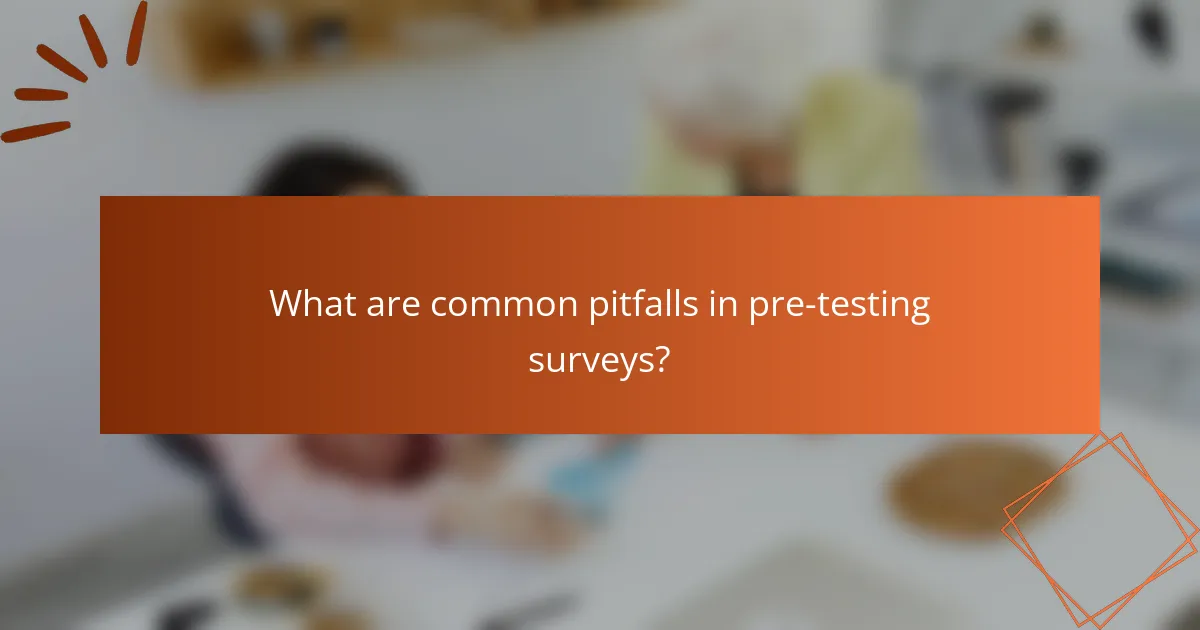
What are common pitfalls in pre-testing surveys?
Common pitfalls in pre-testing surveys include overlooking key demographic factors, failing to pilot test with a representative sample, and neglecting to analyze feedback thoroughly. These mistakes can lead to biased results and ineffective survey designs.
Ignoring demographic diversity
Ignoring demographic diversity can significantly skew survey results. When a survey does not account for variations in age, gender, ethnicity, or socioeconomic status, it risks misrepresenting the target population’s views and experiences.
To ensure a comprehensive understanding, include diverse demographic groups in the pre-testing phase. This can involve stratifying samples or using quotas to reflect the population accurately. For instance, if surveying a city, ensure that different neighborhoods and income levels are represented.
Common pitfalls include assuming that a homogenous group can provide insights applicable to a broader audience. Always consider how demographic factors might influence responses and adjust your survey design accordingly.
